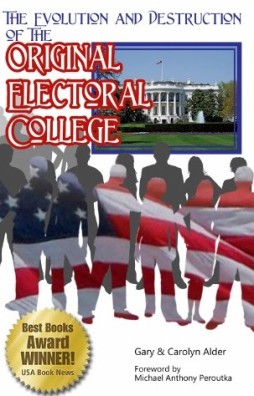A Page from Our Book
Page 61 – President/Vice-President Teams
By the next election the political factions or parties had increased their control and changed the whole complexion of the process. Instead of selecting Electors to suggest (nominate) the best candidates, as the electoral system was designed to do, the Electors were being chosen to support specific candidates previously selected by each party. In addition to this, the president/vice-president team concept was pushed by the parties. This effectively usurped the nominating function from the Electors and turned it over to the political parties. We consider this a serious breach of the Electors’ constitutionally delegated responsibility. While this type of activity is very common among so-called “democratic” societies, it is contrary to the instruction in the Constitution.
In addition to giving the incumbent office holders a level of power approaching a political monopoly, it allowed the political parties to have excessive influence over the Electors and subsequently over the President who would be elected by them. This influence is contrary and repugnant to the intent of the Constitution. The whole direction of the system was evolving into a political battle destined to have all of the negative characteristics that the original system was designed to avoid. Allegiance to party interest became more important to the people than the principle of reconciling separate interests. Intrigue and corruption became the order of the day. Rumors and lies in the media as well as in personal communications were rampant. The whole electoral process was being perverted. The constitutional republic had become largely a representative democracy, subject to the demagoguery and deceit that goes along with rabble rousing.
The Election of 1800
The election of 1800 caused the actual selection of the President to go to the House of Representatives. By now the idea that the election would go to the House under any circumstance was considered problematic by the political parties. We maintain that it would have been a normal and common occurrence for the system as outlined in the original Constitution to put five candidates in the hands of the House for a selection. In fact, we believe that it would almost always have happened this way had the original system been maintained.
The electoral vote in this case ended in a tie with two candidates being nominated by a majority of the Electors. In the context of independent Electors, this seems statistically impossible. In a party context, or a president/vice-president team context, it would be probable.
Counting the Electors’ Votes
The certificates from the Electors were opened and tallied on Wednesday, February 11th 1801 in the Senate chambers. The declaration was made that there was a tie in electoral votes for the office of President. Thomas Jefferson and Aaron Burr each had received votes from a majority of the 138 Electors (276 votes total) and were tied with 73 votes each. This would have been extremely rare with independent Electors. What appears even more unlikely is that the tied candidates also belonged to the same political faction, (Democratic-Republican). Although the sitting Vice-President was one of the tied candidates, the sitting President was not. It seems rather odd that President John Adams would not have received more electoral nominations than the lesser known nominee, Aaron Burr. Of the remaining electoral votes, there were 65 for John Adams and 64 for Charles C. Pinckney. One vote was cast for John Jay. The electoral votes were as follows:
| Thomas Jefferson | 73 |
| Aaron Burr | 73 |
| John Adams | 65 |
| Charles C. Pinckney | 64 |
| John Jay | 1 |
Among 138 supposedly independent Electors there were only five nominees. This says that the Electors in the several states only found five individuals in the country worthy in their opinion of being President. No narrowing down of the field of candidates was necessary. It is obvious that the political parties had taken total control of the candidate selection process (Phase 2) as well as the nomination (Phase 1). It appears that the Federalists were smarter with their president/vice-president strategy than the Democratic-Republicans. Either the Republicans forgot to designate an Elector to vote for a different “vice-president” or the Elector forgot to do his “duty”.


